Individual Project Report: Office Relocation (POPP5013)
VerifiedAdded on 2022/09/06
|24
|4188
|35
Report
AI Summary
This report presents a comprehensive project management plan for the relocation of an office from Metropolis City Centre to a new business park, involving 250 staff members. The project, constrained by both time (3 months) and budget (£50,000), requires careful planning to address complexities in building selection and refurbishment. The report details the project's three phases: office space selection, building preparation, and staff/equipment transfer. It employs six key methods: PESTLE analysis to assess external factors, a Work Breakdown Structure (WBS) to organize tasks, a Gantt chart for scheduling, risk analysis to identify potential issues, a RACI matrix to define responsibilities, and a stakeholder management strategy to align expectations. The PESTLE analysis identifies political, economic, technological, and legal factors impacting the project. The WBS breaks down the project into manageable phases and tasks. The Gantt chart visualizes tasks, timelines, and resources. Risk analysis and the RACI matrix ensure effective management and accountability. The report emphasizes the importance of these methods for successful project execution and provides detailed appendices with supporting documentation.

Running head: PM
Project A: Office Relocation
Name of Student
Name of University
Author Note
Project A: Office Relocation
Name of Student
Name of University
Author Note
Paraphrase This Document
Need a fresh take? Get an instant paraphrase of this document with our AI Paraphraser

1
PM
Table of Contents
Introduction/Project Context...............................................................................................2
Rationale of the Proposed Plan and Choice of Methods.....................................................3
1. PESTLE Analysis............................................................................................................4
2. Work Breakdown Structure (WBS).................................................................................5
3. Gantt Chart.......................................................................................................................7
3.1. Importance of Gantt chart.........................................................................................8
4. Risk Analysis...................................................................................................................8
5. RACI Matrix..................................................................................................................13
6. Stakeholder Management Strategy................................................................................14
Conclusion.........................................................................................................................17
References..........................................................................................................................18
Appendices........................................................................................................................18
Appendix 1: PESTLE Analysis.....................................................................................18
Appendix 2: WBS..........................................................................................................18
Appendix 3: Gantt chart.................................................................................................19
Appendix 4: Risk Analysis............................................................................................20
Appendix 5: RACI Matrix.............................................................................................21
Appendix 6: Stakeholder Management Strategy...........................................................23
PM
Table of Contents
Introduction/Project Context...............................................................................................2
Rationale of the Proposed Plan and Choice of Methods.....................................................3
1. PESTLE Analysis............................................................................................................4
2. Work Breakdown Structure (WBS).................................................................................5
3. Gantt Chart.......................................................................................................................7
3.1. Importance of Gantt chart.........................................................................................8
4. Risk Analysis...................................................................................................................8
5. RACI Matrix..................................................................................................................13
6. Stakeholder Management Strategy................................................................................14
Conclusion.........................................................................................................................17
References..........................................................................................................................18
Appendices........................................................................................................................18
Appendix 1: PESTLE Analysis.....................................................................................18
Appendix 2: WBS..........................................................................................................18
Appendix 3: Gantt chart.................................................................................................19
Appendix 4: Risk Analysis............................................................................................20
Appendix 5: RACI Matrix.............................................................................................21
Appendix 6: Stakeholder Management Strategy...........................................................23
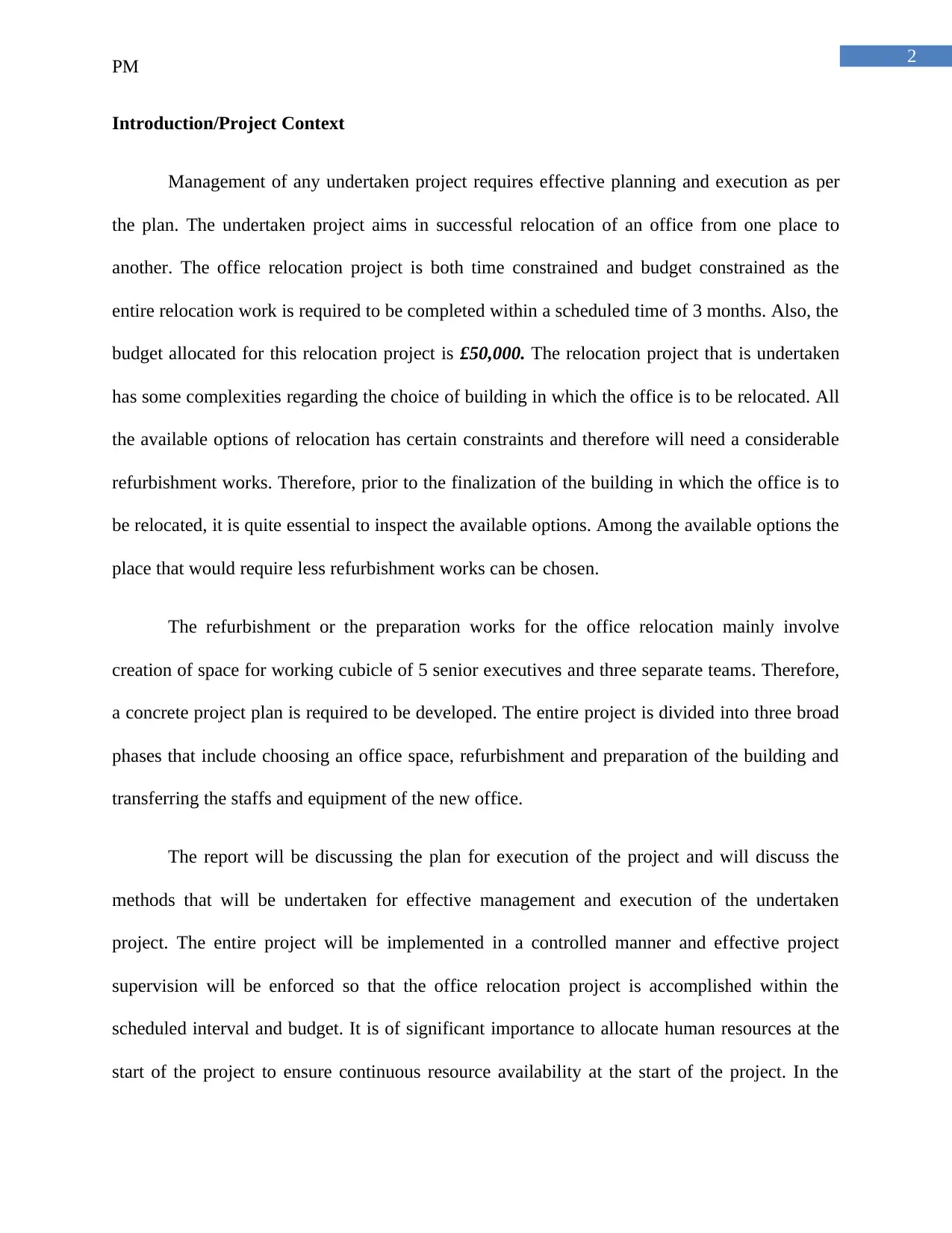
2
PM
Introduction/Project Context
Management of any undertaken project requires effective planning and execution as per
the plan. The undertaken project aims in successful relocation of an office from one place to
another. The office relocation project is both time constrained and budget constrained as the
entire relocation work is required to be completed within a scheduled time of 3 months. Also, the
budget allocated for this relocation project is £50,000. The relocation project that is undertaken
has some complexities regarding the choice of building in which the office is to be relocated. All
the available options of relocation has certain constraints and therefore will need a considerable
refurbishment works. Therefore, prior to the finalization of the building in which the office is to
be relocated, it is quite essential to inspect the available options. Among the available options the
place that would require less refurbishment works can be chosen.
The refurbishment or the preparation works for the office relocation mainly involve
creation of space for working cubicle of 5 senior executives and three separate teams. Therefore,
a concrete project plan is required to be developed. The entire project is divided into three broad
phases that include choosing an office space, refurbishment and preparation of the building and
transferring the staffs and equipment of the new office.
The report will be discussing the plan for execution of the project and will discuss the
methods that will be undertaken for effective management and execution of the undertaken
project. The entire project will be implemented in a controlled manner and effective project
supervision will be enforced so that the office relocation project is accomplished within the
scheduled interval and budget. It is of significant importance to allocate human resources at the
start of the project to ensure continuous resource availability at the start of the project. In the
PM
Introduction/Project Context
Management of any undertaken project requires effective planning and execution as per
the plan. The undertaken project aims in successful relocation of an office from one place to
another. The office relocation project is both time constrained and budget constrained as the
entire relocation work is required to be completed within a scheduled time of 3 months. Also, the
budget allocated for this relocation project is £50,000. The relocation project that is undertaken
has some complexities regarding the choice of building in which the office is to be relocated. All
the available options of relocation has certain constraints and therefore will need a considerable
refurbishment works. Therefore, prior to the finalization of the building in which the office is to
be relocated, it is quite essential to inspect the available options. Among the available options the
place that would require less refurbishment works can be chosen.
The refurbishment or the preparation works for the office relocation mainly involve
creation of space for working cubicle of 5 senior executives and three separate teams. Therefore,
a concrete project plan is required to be developed. The entire project is divided into three broad
phases that include choosing an office space, refurbishment and preparation of the building and
transferring the staffs and equipment of the new office.
The report will be discussing the plan for execution of the project and will discuss the
methods that will be undertaken for effective management and execution of the undertaken
project. The entire project will be implemented in a controlled manner and effective project
supervision will be enforced so that the office relocation project is accomplished within the
scheduled interval and budget. It is of significant importance to allocate human resources at the
start of the project to ensure continuous resource availability at the start of the project. In the
⊘ This is a preview!⊘
Do you want full access?
Subscribe today to unlock all pages.

Trusted by 1+ million students worldwide
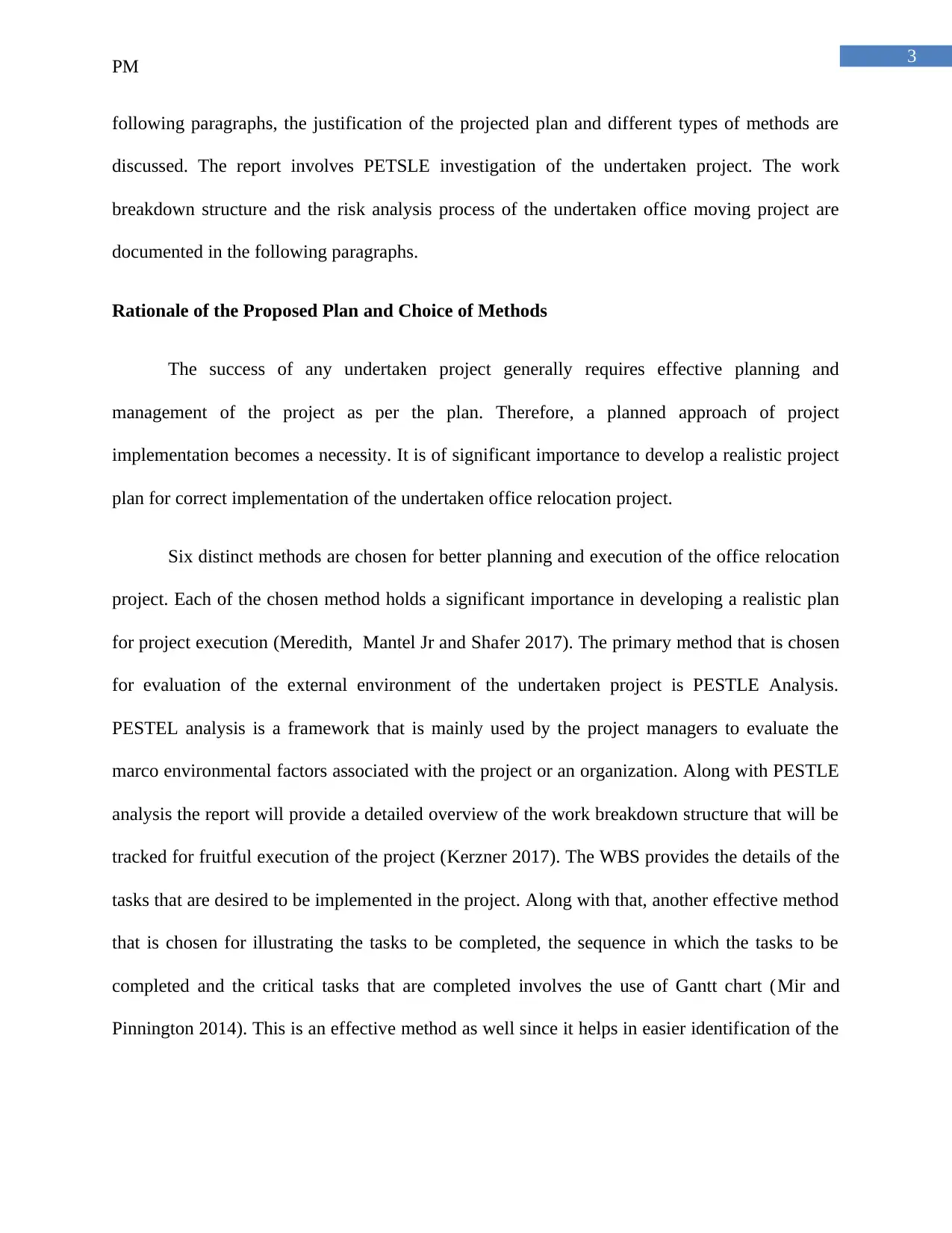
3
PM
following paragraphs, the justification of the projected plan and different types of methods are
discussed. The report involves PETSLE investigation of the undertaken project. The work
breakdown structure and the risk analysis process of the undertaken office moving project are
documented in the following paragraphs.
Rationale of the Proposed Plan and Choice of Methods
The success of any undertaken project generally requires effective planning and
management of the project as per the plan. Therefore, a planned approach of project
implementation becomes a necessity. It is of significant importance to develop a realistic project
plan for correct implementation of the undertaken office relocation project.
Six distinct methods are chosen for better planning and execution of the office relocation
project. Each of the chosen method holds a significant importance in developing a realistic plan
for project execution (Meredith, Mantel Jr and Shafer 2017). The primary method that is chosen
for evaluation of the external environment of the undertaken project is PESTLE Analysis.
PESTEL analysis is a framework that is mainly used by the project managers to evaluate the
marco environmental factors associated with the project or an organization. Along with PESTLE
analysis the report will provide a detailed overview of the work breakdown structure that will be
tracked for fruitful execution of the project (Kerzner 2017). The WBS provides the details of the
tasks that are desired to be implemented in the project. Along with that, another effective method
that is chosen for illustrating the tasks to be completed, the sequence in which the tasks to be
completed and the critical tasks that are completed involves the use of Gantt chart (Mir and
Pinnington 2014). This is an effective method as well since it helps in easier identification of the
PM
following paragraphs, the justification of the projected plan and different types of methods are
discussed. The report involves PETSLE investigation of the undertaken project. The work
breakdown structure and the risk analysis process of the undertaken office moving project are
documented in the following paragraphs.
Rationale of the Proposed Plan and Choice of Methods
The success of any undertaken project generally requires effective planning and
management of the project as per the plan. Therefore, a planned approach of project
implementation becomes a necessity. It is of significant importance to develop a realistic project
plan for correct implementation of the undertaken office relocation project.
Six distinct methods are chosen for better planning and execution of the office relocation
project. Each of the chosen method holds a significant importance in developing a realistic plan
for project execution (Meredith, Mantel Jr and Shafer 2017). The primary method that is chosen
for evaluation of the external environment of the undertaken project is PESTLE Analysis.
PESTEL analysis is a framework that is mainly used by the project managers to evaluate the
marco environmental factors associated with the project or an organization. Along with PESTLE
analysis the report will provide a detailed overview of the work breakdown structure that will be
tracked for fruitful execution of the project (Kerzner 2017). The WBS provides the details of the
tasks that are desired to be implemented in the project. Along with that, another effective method
that is chosen for illustrating the tasks to be completed, the sequence in which the tasks to be
completed and the critical tasks that are completed involves the use of Gantt chart (Mir and
Pinnington 2014). This is an effective method as well since it helps in easier identification of the
Paraphrase This Document
Need a fresh take? Get an instant paraphrase of this document with our AI Paraphraser

4
PM
tasks that falls under the critical path. Also the Gantt chart provides the details of the resources
needed and the cost of each task.
Risk management is important for any project as it helps in easier identification of the
key issues that can affect the normal execution of a project. Therefore, an effective risk analysis
process of the office relocation project is further documented in this report. Along with risk
management, a RACI matrix is designed as well that provides an idea of the Responsibility,
Accountability, Consulates and the informed stakeholders and the resources of the project (Leach
2014). Stakeholders are an important part of any project and plan for a project is mainly prepared
on basis of the expectations of the stakeholders. The stakeholders’ expectations are analysed in
this report by producing an effective stakeholder management strategy. Thus, it can be said that
the use of the six methods provide an idea of the various factors that are important for
developing a project plan. The detailed analysis of the undertaken office relocation project is
presented in the following paragraphs in a detailed manner.
1. PESTLE Analysis
PESTLE is a framework that is generally used for monitoring the macro environmental
factors and its effect on performance of an organization (Cadle, Paul and Turner 2014). In this
case, the PESTLE investigation of the undertaken office transfer project is depicted in appendix
1. In the table depicted in appendix 1, the details of the external factors that can have an effect on
the effective accomplishment of the project is discussed. The success of the office relocation
project largely depends on the fulfilment of those factors and condition. The method of PESTLE
is chosen to get an idea of the macro environmental factors associated with the execution of the
project. The six factors that are depicted in the PESTLE analysis in the appendix 1 are depicting
PM
tasks that falls under the critical path. Also the Gantt chart provides the details of the resources
needed and the cost of each task.
Risk management is important for any project as it helps in easier identification of the
key issues that can affect the normal execution of a project. Therefore, an effective risk analysis
process of the office relocation project is further documented in this report. Along with risk
management, a RACI matrix is designed as well that provides an idea of the Responsibility,
Accountability, Consulates and the informed stakeholders and the resources of the project (Leach
2014). Stakeholders are an important part of any project and plan for a project is mainly prepared
on basis of the expectations of the stakeholders. The stakeholders’ expectations are analysed in
this report by producing an effective stakeholder management strategy. Thus, it can be said that
the use of the six methods provide an idea of the various factors that are important for
developing a project plan. The detailed analysis of the undertaken office relocation project is
presented in the following paragraphs in a detailed manner.
1. PESTLE Analysis
PESTLE is a framework that is generally used for monitoring the macro environmental
factors and its effect on performance of an organization (Cadle, Paul and Turner 2014). In this
case, the PESTLE investigation of the undertaken office transfer project is depicted in appendix
1. In the table depicted in appendix 1, the details of the external factors that can have an effect on
the effective accomplishment of the project is discussed. The success of the office relocation
project largely depends on the fulfilment of those factors and condition. The method of PESTLE
is chosen to get an idea of the macro environmental factors associated with the execution of the
project. The six factors that are depicted in the PESTLE analysis in the appendix 1 are depicting

5
PM
the external factors that can affect the normal implementation of the undertaken business and
therefore, those factors are to be prioritized.
The method of PESTLE is incorporated in planning the office relocation project as this
technique has several advantages. PESTLE analysis is mainly done to determine the long term
effect of certain factors on a particular project (Rastogi et al. 2016). Also this type of analysis is
particularly necessary to review the key strategies that are in place. For example, in this office
relocation project, the political and the economic factors are in place since the office is being
relocated in the fringe of the Metropolis City Centre and the budget set for the project is £50,000.
Therefore, these two conditions of the project are fulfilled, which further indicate that no risk
will arise from these two factors. However, the technological or legal needs associated with the
correct implementation of this project is needed to be addressed so that those factors does not act
as a roadblock to the project success.
Another key advantage of PESTLE is that, it not only helps in identification of the
problem, but also helps in identification of the solution to that problem (Paul, Yeates and Cadle
2014). It is basically important for evaluation of the market risks that are associated with a
project and also helps in elimination of those risk from source so that their negative impact on
the project that is to be completed, can be reduced or completely eliminated (Perera 2017). The
PESTLE analysis have helped in identification of the treats and weakness of the office relocation
project and therefore, use of this particular method is justified.
2. Work Breakdown Structure (WBS)
The work breakdown structure can be described as a deliverable hierarchical
decomposition of the key work processes that are needed to be executed by the team for
PM
the external factors that can affect the normal implementation of the undertaken business and
therefore, those factors are to be prioritized.
The method of PESTLE is incorporated in planning the office relocation project as this
technique has several advantages. PESTLE analysis is mainly done to determine the long term
effect of certain factors on a particular project (Rastogi et al. 2016). Also this type of analysis is
particularly necessary to review the key strategies that are in place. For example, in this office
relocation project, the political and the economic factors are in place since the office is being
relocated in the fringe of the Metropolis City Centre and the budget set for the project is £50,000.
Therefore, these two conditions of the project are fulfilled, which further indicate that no risk
will arise from these two factors. However, the technological or legal needs associated with the
correct implementation of this project is needed to be addressed so that those factors does not act
as a roadblock to the project success.
Another key advantage of PESTLE is that, it not only helps in identification of the
problem, but also helps in identification of the solution to that problem (Paul, Yeates and Cadle
2014). It is basically important for evaluation of the market risks that are associated with a
project and also helps in elimination of those risk from source so that their negative impact on
the project that is to be completed, can be reduced or completely eliminated (Perera 2017). The
PESTLE analysis have helped in identification of the treats and weakness of the office relocation
project and therefore, use of this particular method is justified.
2. Work Breakdown Structure (WBS)
The work breakdown structure can be described as a deliverable hierarchical
decomposition of the key work processes that are needed to be executed by the team for
⊘ This is a preview!⊘
Do you want full access?
Subscribe today to unlock all pages.

Trusted by 1+ million students worldwide

6
PM
accomplishing the key objectives of an undertaken project (Crawford 2014). Also the key
deliverables and the milestone of an undertaken project is documented in the WBS. The WBS of
the office relocation project that has been undertaken is illustrated in the figure below-
Figure 1: Illustrating the WBS of the Office Relocation Project
(Source: created by author using MS Project and MS schedule Pro)
The picture above illustrated the work processes that are needed to be completed for
efficacious accomplishment of the office relocation. The entire office relocation venture is
divided into certain number of phases and each phases involves certain specific task that are
needed to be completed for successful project implementation (Harrison and Lock 2017). The
detailed WBS of the undertaken project is indicated in the appendix 2.
In project management, development of a WBS of a project becomes mandatory as it is
an effective tool that organizes the work of a team into various manageable section. The WBS is
vital as it helps in reducing the complicated activities of a critical project into simple and
PM
accomplishing the key objectives of an undertaken project (Crawford 2014). Also the key
deliverables and the milestone of an undertaken project is documented in the WBS. The WBS of
the office relocation project that has been undertaken is illustrated in the figure below-
Figure 1: Illustrating the WBS of the Office Relocation Project
(Source: created by author using MS Project and MS schedule Pro)
The picture above illustrated the work processes that are needed to be completed for
efficacious accomplishment of the office relocation. The entire office relocation venture is
divided into certain number of phases and each phases involves certain specific task that are
needed to be completed for successful project implementation (Harrison and Lock 2017). The
detailed WBS of the undertaken project is indicated in the appendix 2.
In project management, development of a WBS of a project becomes mandatory as it is
an effective tool that organizes the work of a team into various manageable section. The WBS is
vital as it helps in reducing the complicated activities of a critical project into simple and
Paraphrase This Document
Need a fresh take? Get an instant paraphrase of this document with our AI Paraphraser
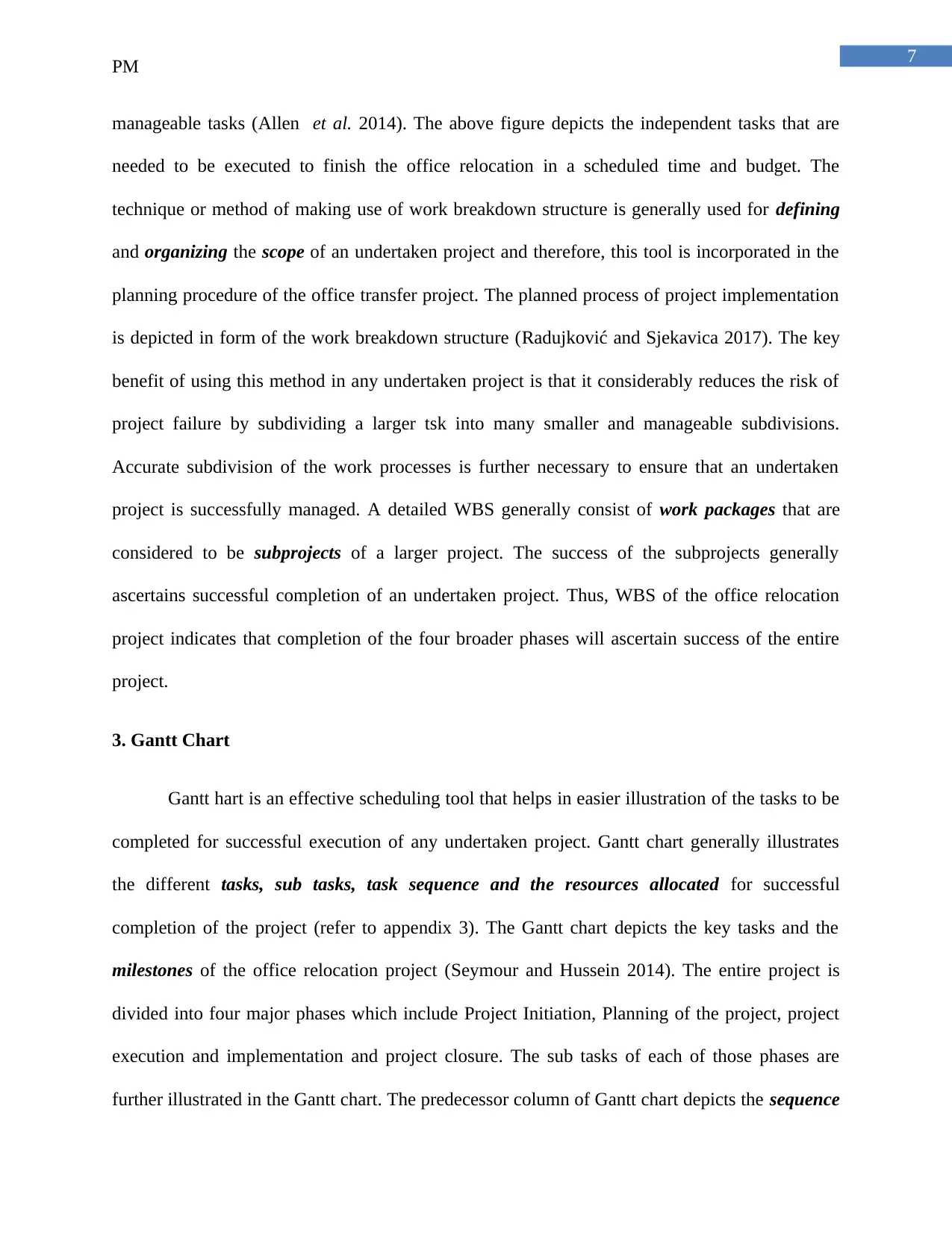
7
PM
manageable tasks (Allen et al. 2014). The above figure depicts the independent tasks that are
needed to be executed to finish the office relocation in a scheduled time and budget. The
technique or method of making use of work breakdown structure is generally used for defining
and organizing the scope of an undertaken project and therefore, this tool is incorporated in the
planning procedure of the office transfer project. The planned process of project implementation
is depicted in form of the work breakdown structure (Radujković and Sjekavica 2017). The key
benefit of using this method in any undertaken project is that it considerably reduces the risk of
project failure by subdividing a larger tsk into many smaller and manageable subdivisions.
Accurate subdivision of the work processes is further necessary to ensure that an undertaken
project is successfully managed. A detailed WBS generally consist of work packages that are
considered to be subprojects of a larger project. The success of the subprojects generally
ascertains successful completion of an undertaken project. Thus, WBS of the office relocation
project indicates that completion of the four broader phases will ascertain success of the entire
project.
3. Gantt Chart
Gantt hart is an effective scheduling tool that helps in easier illustration of the tasks to be
completed for successful execution of any undertaken project. Gantt chart generally illustrates
the different tasks, sub tasks, task sequence and the resources allocated for successful
completion of the project (refer to appendix 3). The Gantt chart depicts the key tasks and the
milestones of the office relocation project (Seymour and Hussein 2014). The entire project is
divided into four major phases which include Project Initiation, Planning of the project, project
execution and implementation and project closure. The sub tasks of each of those phases are
further illustrated in the Gantt chart. The predecessor column of Gantt chart depicts the sequence
PM
manageable tasks (Allen et al. 2014). The above figure depicts the independent tasks that are
needed to be executed to finish the office relocation in a scheduled time and budget. The
technique or method of making use of work breakdown structure is generally used for defining
and organizing the scope of an undertaken project and therefore, this tool is incorporated in the
planning procedure of the office transfer project. The planned process of project implementation
is depicted in form of the work breakdown structure (Radujković and Sjekavica 2017). The key
benefit of using this method in any undertaken project is that it considerably reduces the risk of
project failure by subdividing a larger tsk into many smaller and manageable subdivisions.
Accurate subdivision of the work processes is further necessary to ensure that an undertaken
project is successfully managed. A detailed WBS generally consist of work packages that are
considered to be subprojects of a larger project. The success of the subprojects generally
ascertains successful completion of an undertaken project. Thus, WBS of the office relocation
project indicates that completion of the four broader phases will ascertain success of the entire
project.
3. Gantt Chart
Gantt hart is an effective scheduling tool that helps in easier illustration of the tasks to be
completed for successful execution of any undertaken project. Gantt chart generally illustrates
the different tasks, sub tasks, task sequence and the resources allocated for successful
completion of the project (refer to appendix 3). The Gantt chart depicts the key tasks and the
milestones of the office relocation project (Seymour and Hussein 2014). The entire project is
divided into four major phases which include Project Initiation, Planning of the project, project
execution and implementation and project closure. The sub tasks of each of those phases are
further illustrated in the Gantt chart. The predecessor column of Gantt chart depicts the sequence
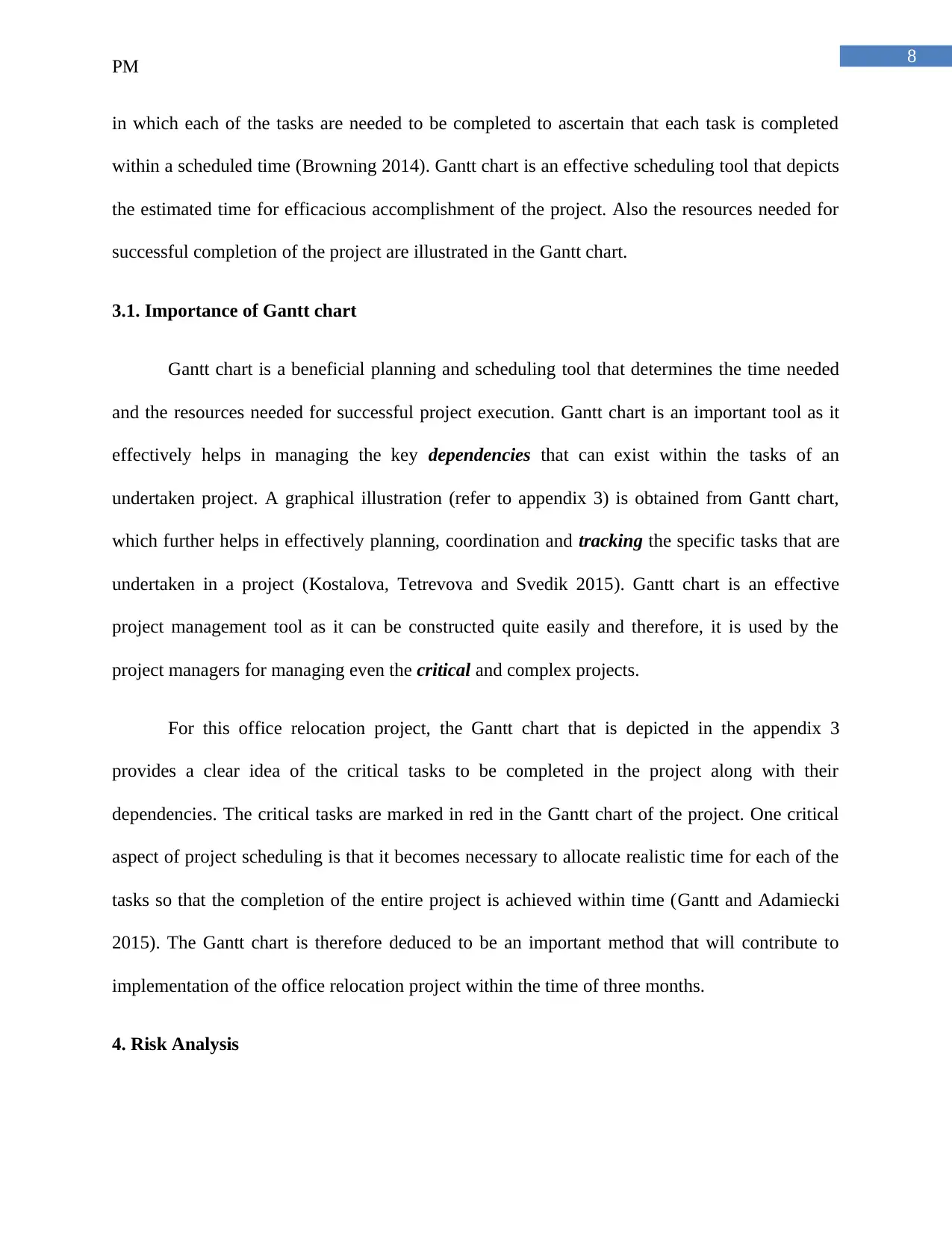
8
PM
in which each of the tasks are needed to be completed to ascertain that each task is completed
within a scheduled time (Browning 2014). Gantt chart is an effective scheduling tool that depicts
the estimated time for efficacious accomplishment of the project. Also the resources needed for
successful completion of the project are illustrated in the Gantt chart.
3.1. Importance of Gantt chart
Gantt chart is a beneficial planning and scheduling tool that determines the time needed
and the resources needed for successful project execution. Gantt chart is an important tool as it
effectively helps in managing the key dependencies that can exist within the tasks of an
undertaken project. A graphical illustration (refer to appendix 3) is obtained from Gantt chart,
which further helps in effectively planning, coordination and tracking the specific tasks that are
undertaken in a project (Kostalova, Tetrevova and Svedik 2015). Gantt chart is an effective
project management tool as it can be constructed quite easily and therefore, it is used by the
project managers for managing even the critical and complex projects.
For this office relocation project, the Gantt chart that is depicted in the appendix 3
provides a clear idea of the critical tasks to be completed in the project along with their
dependencies. The critical tasks are marked in red in the Gantt chart of the project. One critical
aspect of project scheduling is that it becomes necessary to allocate realistic time for each of the
tasks so that the completion of the entire project is achieved within time (Gantt and Adamiecki
2015). The Gantt chart is therefore deduced to be an important method that will contribute to
implementation of the office relocation project within the time of three months.
4. Risk Analysis
PM
in which each of the tasks are needed to be completed to ascertain that each task is completed
within a scheduled time (Browning 2014). Gantt chart is an effective scheduling tool that depicts
the estimated time for efficacious accomplishment of the project. Also the resources needed for
successful completion of the project are illustrated in the Gantt chart.
3.1. Importance of Gantt chart
Gantt chart is a beneficial planning and scheduling tool that determines the time needed
and the resources needed for successful project execution. Gantt chart is an important tool as it
effectively helps in managing the key dependencies that can exist within the tasks of an
undertaken project. A graphical illustration (refer to appendix 3) is obtained from Gantt chart,
which further helps in effectively planning, coordination and tracking the specific tasks that are
undertaken in a project (Kostalova, Tetrevova and Svedik 2015). Gantt chart is an effective
project management tool as it can be constructed quite easily and therefore, it is used by the
project managers for managing even the critical and complex projects.
For this office relocation project, the Gantt chart that is depicted in the appendix 3
provides a clear idea of the critical tasks to be completed in the project along with their
dependencies. The critical tasks are marked in red in the Gantt chart of the project. One critical
aspect of project scheduling is that it becomes necessary to allocate realistic time for each of the
tasks so that the completion of the entire project is achieved within time (Gantt and Adamiecki
2015). The Gantt chart is therefore deduced to be an important method that will contribute to
implementation of the office relocation project within the time of three months.
4. Risk Analysis
⊘ This is a preview!⊘
Do you want full access?
Subscribe today to unlock all pages.

Trusted by 1+ million students worldwide

9
PM
Uncertainties and risks are quite common in any project and therefore, it becomes
integral to manage those risks. The office relocation project is to be completed within a time of
three months and therefore, risk identification and mitigation at the start of the project becomes a
necessity (Marcelino-Sádaba et al. 2014). The following table below provides an idea of the key
risks, their probability of occurrence in the project and the impact those risk can have on the
normal execution of the project.
PM
Uncertainties and risks are quite common in any project and therefore, it becomes
integral to manage those risks. The office relocation project is to be completed within a time of
three months and therefore, risk identification and mitigation at the start of the project becomes a
necessity (Marcelino-Sádaba et al. 2014). The following table below provides an idea of the key
risks, their probability of occurrence in the project and the impact those risk can have on the
normal execution of the project.
Paraphrase This Document
Need a fresh take? Get an instant paraphrase of this document with our AI Paraphraser
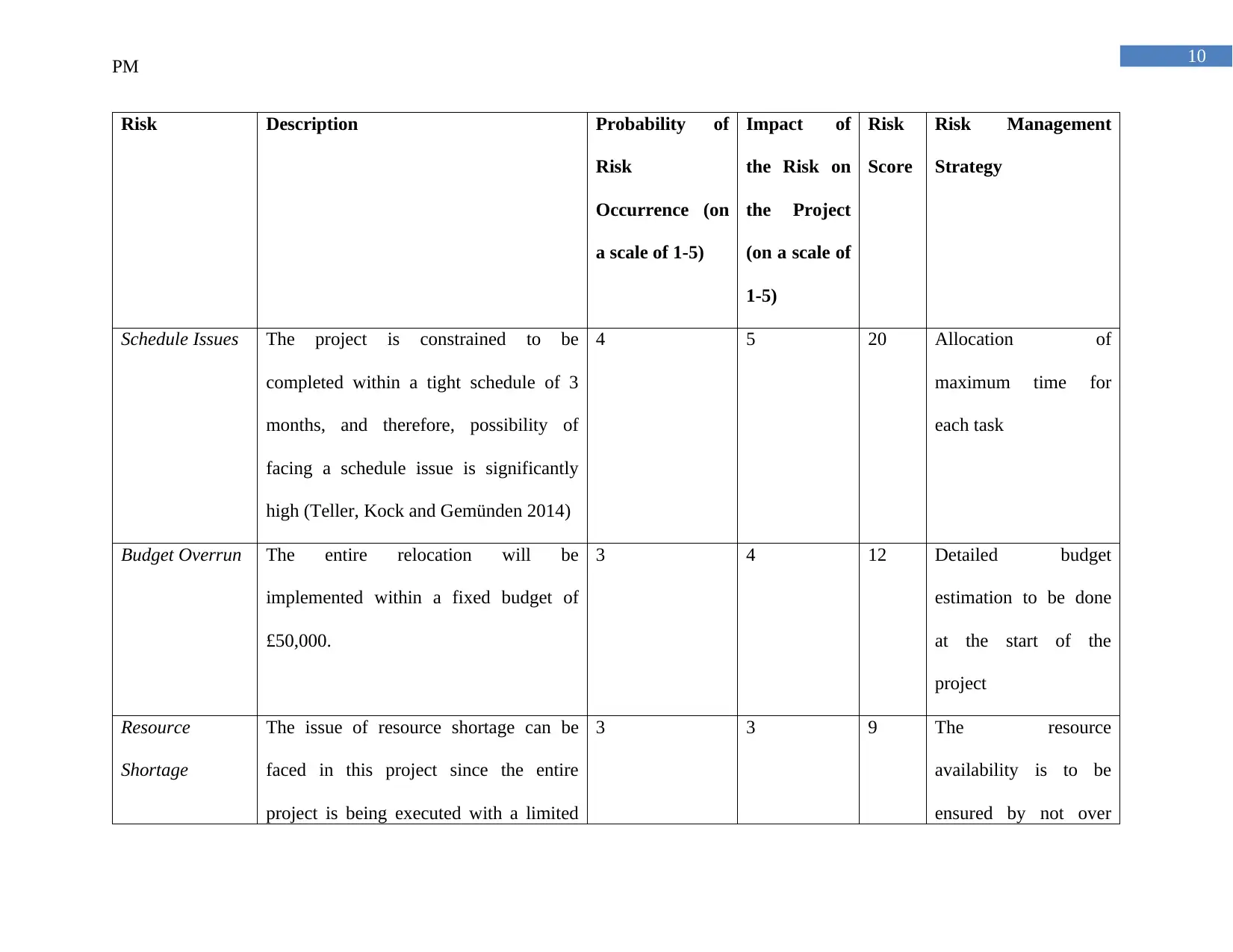
10
PM
Risk Description Probability of
Risk
Occurrence (on
a scale of 1-5)
Impact of
the Risk on
the Project
(on a scale of
1-5)
Risk
Score
Risk Management
Strategy
Schedule Issues The project is constrained to be
completed within a tight schedule of 3
months, and therefore, possibility of
facing a schedule issue is significantly
high (Teller, Kock and Gemünden 2014)
4 5 20 Allocation of
maximum time for
each task
Budget Overrun The entire relocation will be
implemented within a fixed budget of
£50,000.
3 4 12 Detailed budget
estimation to be done
at the start of the
project
Resource
Shortage
The issue of resource shortage can be
faced in this project since the entire
project is being executed with a limited
3 3 9 The resource
availability is to be
ensured by not over
PM
Risk Description Probability of
Risk
Occurrence (on
a scale of 1-5)
Impact of
the Risk on
the Project
(on a scale of
1-5)
Risk
Score
Risk Management
Strategy
Schedule Issues The project is constrained to be
completed within a tight schedule of 3
months, and therefore, possibility of
facing a schedule issue is significantly
high (Teller, Kock and Gemünden 2014)
4 5 20 Allocation of
maximum time for
each task
Budget Overrun The entire relocation will be
implemented within a fixed budget of
£50,000.
3 4 12 Detailed budget
estimation to be done
at the start of the
project
Resource
Shortage
The issue of resource shortage can be
faced in this project since the entire
project is being executed with a limited
3 3 9 The resource
availability is to be
ensured by not over

11
PM
resource (Kliem and Ludin 2019). allocating the existing
resources
Lack of Proper
Space
The success of the relocation project
depends on finding a place that ill suit the
needs of the entire office. Delay in
finding such place in the periphery of the
Metropolis city centre can result in
project failure.
2 5 10 Office space to be
booked in advance
Employee
Resistance for
relocation
The accomplishment of the relocation
project is subjected to funding from the
existing employees (Carvalho and
Rabechini Junior 2015). Any issue
arising from the employees might result
in project delay
2 4 8 Employees can be
involved in decision
making
Technological
Issue
The technological issue can be faced
while relocation of the IT assets of the
3 5 15 Help of a technical
expert can be taken.
PM
resource (Kliem and Ludin 2019). allocating the existing
resources
Lack of Proper
Space
The success of the relocation project
depends on finding a place that ill suit the
needs of the entire office. Delay in
finding such place in the periphery of the
Metropolis city centre can result in
project failure.
2 5 10 Office space to be
booked in advance
Employee
Resistance for
relocation
The accomplishment of the relocation
project is subjected to funding from the
existing employees (Carvalho and
Rabechini Junior 2015). Any issue
arising from the employees might result
in project delay
2 4 8 Employees can be
involved in decision
making
Technological
Issue
The technological issue can be faced
while relocation of the IT assets of the
3 5 15 Help of a technical
expert can be taken.
⊘ This is a preview!⊘
Do you want full access?
Subscribe today to unlock all pages.

Trusted by 1+ million students worldwide
1 out of 24
Related Documents
Your All-in-One AI-Powered Toolkit for Academic Success.
+13062052269
info@desklib.com
Available 24*7 on WhatsApp / Email
![[object Object]](/_next/static/media/star-bottom.7253800d.svg)
Unlock your academic potential
Copyright © 2020–2025 A2Z Services. All Rights Reserved. Developed and managed by ZUCOL.





